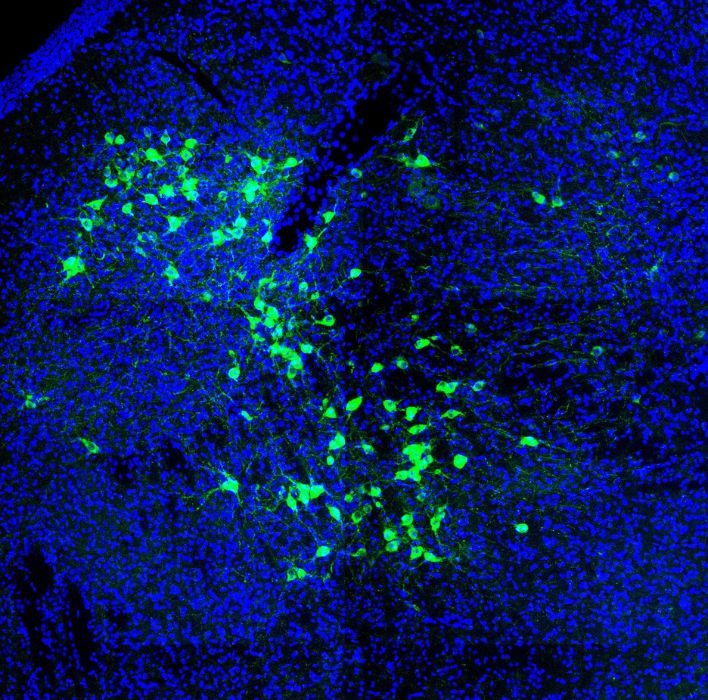
Brainstem orchestration of cue-reward associations
The brain constantly integrates new sensory information, and associates environmental cues to outcomes, adjusting behavior to maximize reward and minimize unpleasant consequences. This process is critical for survival, and its dysregulation is a hallmark of several neuropsychiatric disorders, including addiction. Cues associated with the delivery of rewards, including drugs and food, can acquire valence, and change behavior. We and others showed that a brainstem region, the laterodorsal tegmentum (LDT) sends direct projections to the nucleus accumbens (NAc), a central brain region of reward processing. We further showed that LDT-NAc cholinergic projections are essential for reward value and motivation towards natural rewards. Yet, little is known about if and how reward signals (natural or drug-related) are encoded in these projections.
Our aim is to understand the role of LDT and its projections in reward-related behaviors, including natural rewards and drugs of abuse. We use a combination of tools including optogenetics, electrophysiology and live imaging with genetically encoded sensors together with behavior.
Understanding how the LDT actively participates in modulating reward signals is ultimately important to better understand disorders in which the reward system is altered such as addiction.
Funding Agency
FCT
Funding Agency
FCT
Project Reference

Project Members


Ana João Rodrigues

Nuno Sousa

Carina Soares-Cunha

Tawan T. A. Carvalho

Ana Verónica Domingues

Raquel Correia
Main Project Outcomes
S. Queirós, “Right ventricular segmentation in multi-view cardiac MRI using a unified U-net model”, in E. Puyol Antón et al. (eds) Statistical Atlases and Computational Models of the Heart. Multi-Disease, Multi-View, and Multi-Center Right Ventricular Segmentation in Cardiac MRI Challenge. STACOM 2021. Lecture Notes in Computer Science, vol 13131, pp. 287-295, Springer, Cham, 2022.
“Best Paper Award in the M&Ms-2 Challenge”, by M&Ms2 Challenge organizers and the Medical Image Computing and Computer Assisted Intervention (MICCAI) Society.
Main Project Outcomes
1. Coimbra B, Soares-Cunha C, Vasconcelos, NAP,Domingues, A. V, Sousa, N, Rodrigues, A. J. Laterodorsal tegmentum–ventral tegmental area projections encode positive reinforcement signals. Journal of Neuroscience Research (2021)
2. Coimbra B, Soares-Cunha C, Vasconcelos NAP, Sousa N, Rodrigues AJ. Role of laterodorsal tegmentum projections to nucleus accumbens in reward-related behaviors”. Nature Communications (2019)
3. Coimbra B, Soares-Cunha C, Borges S, Vasconcelos NAP, Sousa N, Rodrigues AJ. Impairments in laterodorsal tegmentum to VTA projections underlie glucocorticoid-triggered reward deficits. eLife. (2017)
4. Prize “Publication in a peer-reviewed journal with the best Impact factor in the Neuroscience Research Domain”, ICVS (2020)



Contact us
Phone: +351 253 604 967
Fax: +351 253 604 809
Email: icvs.sec@med.uminho.pt
Address
Life and Health Sciences
Research Institute (ICVS)
School of Medicine,
University of Minho,
Campus de Gualtar
4710-057 Braga
Portugal

Copyright ©2025 ICVS. All Rights Reserved. Developed by TCIT



Copyright ©2025 ICVS. All Rights Reserved. Developed by TCIT
Address
Life and Health Sciences
Research Institute (ICVS)
School of Medicine,
University of Minho,
Campus de Gualtar
4710-057 Braga
Portugal



Copyright ©2025 ICVS. All Rights Reserved
Address
Life and Health Sciences
Research Institute (ICVS)
School of Medicine,
University of Minho,
Campus de Gualtar
4710-057 Braga
Portugal





